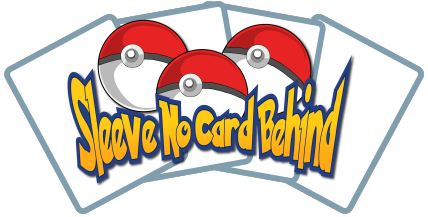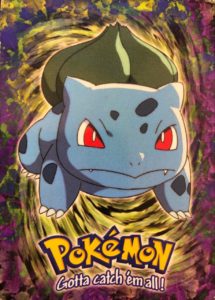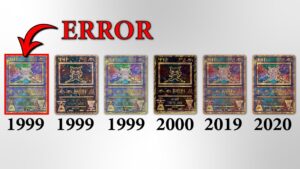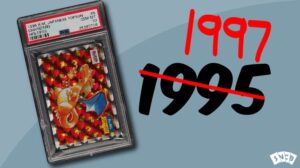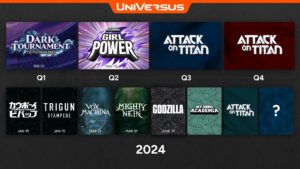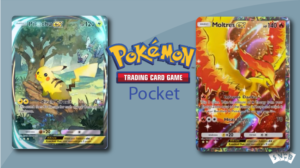Topps Pokémon Cards- Ultimate Guide (with prices)
-
By: Oliver Copeland
- Published:
- Last Updated: December 3, 2023
If you collected Pokémon cards as a kid in the late 90s or if you collect them now, you may have some different cards in your collection. These don’t look like the regular TCG cards but are unique in their own way. Chances are, these could be TOPPS cards. TOPPS cards are made by a company separate from The Pokémon Company and can’t be played the same as the other cards are. So what are TOPPS cards, and are they worth anything?
The original TOPPS cards (TOPSUN)
In March 1997 the first TOPPS cards were released in Japan only. Of course, the company was still called TOPSUN at the time, as they changed their name later on. The cards feature a Pokémon on the front and have only a pattern on the back that is TOPSUN repeated in Japanese. At the bottom of the face of the card, there is a 1995 copyright. This can be misleading as these cards are not from 1995, but 1997. The 1995 date is reflecting the date of the property of Pokémon itself, but TOPSUN actually filed its patent in 1997.
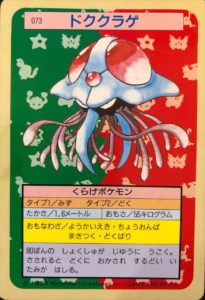
These cards were only available in packs of chewing gum, and only in the green apple flavor. There are only 150 cards, one for each Pokémon. It’s important to remember that Mew did not yet exist, therefore there is no card for Mew.
There are two different variations of TOPSUN cards- blue-backs and green-backs. Blue-backs were released first and are much rarer than green-backs. There are also holo TOPSUN cards, but only 16 instead of the 150. These 16 holo TOPSUN cards, referred to as prism holos, were not only holo versions of the regular cards but featured more of a “full art” design on the front.
While the blue-backs are rarer and more valuable, there is a more valuable version yet. Some blue-backs were accidentally printed without a number to the left of the Pokémon name at the top of the card. This is referred to as the ‘no-number error blue-back. These cards are increasing in value at a rapid rate, as they are often regarded as some of the oldest Pokémon cards ever printed.
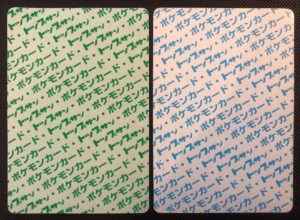
TOPPS continued to print and sell Pokémon cards after the success of the first set. From 2000 to 2003, TOPPS distributed Pokéon products in over 44 countries and 25 languages.
If you want to know more about Topsaun cards, check out our complete Topsun guide.
You can usually find really good deals on TOPSUN cards on eBay.
Does TOPPS still make Pokémon cards?
Today, TOPPS no longer makes Pokémon cards, as sales plummeted when the TCG gained popularity around the world. TOPPS’ Pokémon license for its entertainment products expired in 2008, with no intention for renewal, as they reported “[Pokémon entertainment products] have experienced peaks and valleys of consumer interest”. –Topps 2007 annual financial report
English TOPPS cards
TOPPS Series 1 (1999)
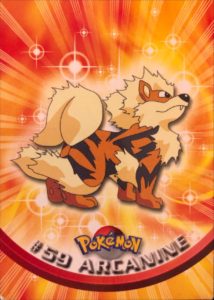
The first TOPPS set to hit the North American market was known as Pokémon Trading Cards Series 1 (commonly referred to as TOPPS Series 1). Series 1 contained 90 cards in total: 76 Pokémon, 13 characters, and one checklist card. Each card was also available in two different foil variations, silver, and rainbow. These cards came in 8-card booster packs, with a guaranteed holo in each pack.
There were five different printings of TOPPS Series 1. Each printing can be identified by the color of the TOPPS logo. However, due to an error, each foil card after and including the second print had a black logo.
Logo Color | Foil Deboss Pattern | |
1st printing | Blue | N/A |
2nd printing | Black | Rays/Starbursts |
3rd printing | Green (non-foil only) | Flames/Teardrops |
4th printing | Red (non-foil only) | Poké Balls/Targets |
5th printing (foil only) | Black | Smooth |
TOPPS then produced a 75th-anniversary set. This set included unique ‘buyback’ cards where TOPPS purchased cards from the secondhand market, applied a gold ‘TOPPS 75th” logo, and distributed the cards.
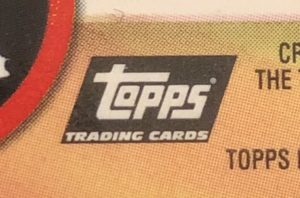
Pokémon the First Movie Trading Cards (1999)
This set was released alongside the first big Pokémon movie in North America and featured many cards with scenes from the movie. They were sold in 8 or 5 card booster packs with a guaranteed foil card in each pack. There were two different printings, the first having a blue TOPPS logo and the second one with a black TOPPS logo.
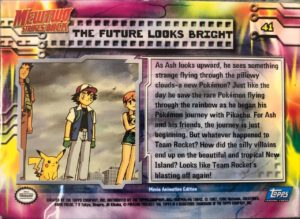
There was a special promo card from this set only available from participating Blockbuster Video stores. The card was numbered 0 in the set and featured Mewtwo on the front.
Pokémon the First Movie Trading Cards contained:
- 41 Mewtwo Strikes Back cards
- 18 Pikachu’s Vacation cards
- 12 Evolution cards
- 1 Checklist card
- 12 Die-cut cards (Bonus)
- 18 Sticker/Puzzle cards (Bonus)

An Evolution card from the Pokémon The First Movie TOPPS set
Pokémon the Movie 2000 Trading Cards (2000)
This set had 5 or 8 card booster packs each with a guaranteed holo. The packs containing rainbow foil cards could be identified by a “Special Collector’s Edition” stamp on the pack itself, and also on the booster box. This set contains the now-famous Lugia card that is worth ~$2,000.
Another unique card from this set is the film frame cards that have authentic 35mm film reel frames built into the cards. These were very rare and each card has its own film cell. Because of this, according to the TOPPS company, no two cards are the same.
Pokémon the Movie 2000 Trading Cards contained:
- 59 The Power of One cards
- 12 Pikachu’s Rescue Adventure cards
- 1 Checklist card
- 10 Movie Scene Sticker cards (Bonus)
- 6 First Appearance Hologram cards (Bonus)
- An unknown number of Film Frame cards
TOPPS Series 2 (2000)
In 2000, Series 2 was released and featured 72 cards, with an additional 27 bonus “chase cards”. Series 2 was available in five or eight card booster packs. The packs containing rainbow foil cards could be identified by a “Special Collector’s Edition” stamp on the pack itself, and also on the booster box.
TOPPS Series 2 contained:
- 41 Pokémon
- 5 “Heroes & Villains”
- 25 Episode cards
- 1 Checklist card
- 12 Die-cut cards (Bonus)
- 10 Animation sticker cards (Bonus)
- 5 Clear cards (Bonus)
TOPPS Series 3 (2000)
Series 3 was released the same year as Series 2, and again brought a 72 card set with an additional 27 bonus cards. Series 3 was available in five or eight card booster packs. The packs containing rainbow foil cards could be identified by a “Special Collector’s Edition” stamp on the pack itself, and also on the booster box.
Series 3 was the first to introduce Puzzle cards and Pop-up cards. There are 6 puzzler cards, each featuring part of an image on the front and back. If all 6 are collected, one can arrange one completed “puzzle” at a time. The pop-up cards each had a character or Pokémon that could be pushed out by the perforated edges and propped up using the rest of the card as a base.
TOPPS Series 3 contained:
- 34 Pokémon
- 12 “Heroes & Villains”
- 19 Episode cards
- 6 Puzzle cards
- 1 Checklist card
- 12 Die-cut cards (Bonus)
- 10 Pop-up cards (Bonus)
- 5 Clear cards (Bonus)
Johto Series 1 (2001)
TOPPS released its biggest set yet in 2001, featuring the second generation of Pokémon from the Pokémon Gold Version & Pokémon Silver Version video games. This set had a whopping 186 cards total. Also, there was now only one foil variant for the base 90 cards. Here is the breakdown:
Johto Series 1 contained:
- 62 Pokémon
- 27 Episode cards
- 1 Checklist card
- 62 Sticker cards (Bonus)
- 15 Die-cut cards (Bonus)
- 10 Pop-up cards (Bonus)
- 9 Hologram cards (Bonus)
Johto League Champions (2001)
Topps returned to the Johto region with a smaller set this time. This set included 50 cards plus 55 bonus cards, for a total of 105. 8-Booster packs now included a guaranteed 1 sticker card, 1 foil card, and 1 die-cut card.
Johto League Champions contained:
- 37 Pokémon
- 12 Episode cards
- 1 Checklist card
- 35 Sticker cards (Bonus)
- 18 Die-cut cards (Bonus)
Advanced (2003)
A new set was released alongside the new Pokémon Gameboy Advance games, featuring the third generation of Pokémon. Booster packs now came in packs of 7, and each pack contained 1 foil card. Pokémon were listed alphabetically in this set, as opposed to the usual Pokédex number.
Advanced contained:
- 81 Pokémon
- 8 Character cards
- 1 Checklist card
- 10 Pop-up cards (Bonus)
- 18 Evolution cards (Bonus)
Advanced Challenge (2004)
This set included Pokémon from generations 1 through 3, and each 7-card booster included a guaranteed foil card.
Advanced Challenge contained:
- 89 Pokémon
- 1 Checklist card
- 10 Pop-up cards (Bonus)
- 18 Evolution cards (Bonus)
Top 10 Collector Cards (2006)
Since 2006 was the 10th anniversary of Pokémon, TOPPS manufactured a special set featuring “Top 10” cards. The set also included unique chase cards such as Die-cut Magnet cards and Foil Parallel cards.
Are TOPPS cards valuable?
Most are not, but some are very valuable. Like any Pokémon card set, the rare ones have grown in value over the years while the common cards have not. Here’s a quick list we put together that shows the most expensive TOPPS cards based on recently sold eBay listings. As you can see, Charizard is always valuable, even as a TOPPS card.
The most valuable TOPPS cards
Click the links to check current prices on eBay.
Charizard Chrome Sparkle (2000) PSA 7 | $3,300 |
Blastoise Chrome Sparkle (2000) PSA 9 | $2,000 |
Charizard Chrome (2000) PSA 10 | $1,500 |
Lugia First Appearance (2000) RAW | $1,500 |
Charmander Chrome (2000) PSA 9 | $1,500 |
Charizard Foil (1999) PSA 10 | $1,450 |
Final thoughts
TOPPS cards are still flying under the radar of most collectors. The TCG has stolen all the limelight and while some PSA graded TOPPS cards are gaining value, most are still very affordable. Even Charizard cards from 1999/2000 are selling for sometimes just double digits. Are TOPPS cards a smart investment? Yes, probably so
